 Sketch of the White House. Credit: LHS archives – 593. Artist unknown 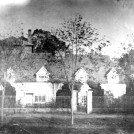 Peacock House. Credit: LHS archives Brewery House still exists (see photograph below), and is now occupied (2013) by W H Smith and Harpenden Interiors (both no.29). The brewery buildings were behind and to the side of the houses. The southern breweryThis is probably the oldest. The Curtis family had a brewery in 1800, probably on this site. There is clear evidence that there was one here in 1837 owned by 27 year old James Curtis and his wife. The custom of breweries owning tied houses was already established. In 1838 he acquired the Queen Victoria in Redbourn, and in 1852 the Rose and Crown at Abbots Langley. James and his wife Elizabeth lived in the White House. In the 1851 census he is described as a 41 year old brewer and maltster. Elizabeth was the same age. Also in the house were a 16 year old niece, “a scholar at home”, and three female house servants. In 1853 the brewery was sold to the Healey family, who were brewers in Watford. |
| George Healey, the eldest son, came with his wife to live in the White House and to manage the Harpenden brewery. In 1861 he was 42, and described as a brewer and maltster, employing twelve men and a boy. He died the following year. His widow Elizabeth , who was seven years younger, ran the business for another twelve years, and then leased it to Benjamin Bennett in 1874. |
| Bennett was already running a small, but successful brewery in Dunstable. He managed the Harpenden brewery for nineteen years, during which time he bought a public house, the White Horse, in Barnet, to add to two he already owned in St Albans. He must have owned the Plough and Harrow at Southdown too. His monogram, a double “B”, is displayed above the windows there. Elizabeth Healey continued to live in the White House. In 1879 during a particularly bad storm the Lower High Street flooded to such a depth that John Healey, her 29 year old son, was able to swim from there to the end of the pond on the Common and back, a feat which has not been done since. Elizabeth Healey died in 1893, Benjamin Bennett’s lease was terminated, and the brewery was sold to Mrs Martha Mardall, together with 18 public houses, for £16,000.
The northern (Peacock) breweryThis was so named because it had a peacock weather vane and topiary hedges. It was founded in about 1826 by James Kingston. He sold it in 1839 to the House family, whose home was the Grove at Southdown. In the beginning, two brothers were managing the brewery, but by 1851 the census records John, a 33 year old bachelor, living at Peacock House. He was described as a brewer and farmer of 120 acres, employing 10 labourers. Also in the house were a housekeeper and a house servant. In 1870 the brewery was put up for sale. The sales notice described the property: “A valuable freehold and copyhold property, the Brewery, desirably situated at Harpenden, near to the railway station, with malt and hop stores, tun rooms, underground cellars, stabling, residence, with spacious and well stocked garden, and two closes of meadow land, containing nearly three acres, together with the fixed plant and machinery in excellent condition. The Brewery is abundantly supplied with water of an unusually pure quality from an artesian well on the premises; also Twelve Public and Beer Houses, situated within easy distances of the Brewery, at Harpenden, Wheathampstead, Redbourn, Gustard Common, Burygreen, Hamwell, Timberlog-green, and Luton. Also the goodwill of the trade carried on for upwards of thirty years by the late Mr J J House and his family.” ( The Silver Cup Beerhouse, with stabling and workshops was offered as a separate lot.) The brewery was bought by James Mardall for £16,000. A year later, in 1871, he demolished Peacock House, and had Brewery House built on its site. Brewery House in 1994. Note Methodist Church to the right and Electricity showroom to the left. Credit: LHS archives – 5002 He lived there with his wife and family until his death in 1881. His widow Martha continued to manage the brewery with assistance from three of her four sons (the fourth son was in the stock exchange). A price list, issued in 1890, shows the range of their products. In 1893 the Mardalls bought the Healey brewery, and combined the two businesses, concentrating all brewing at the Mardall brewery. 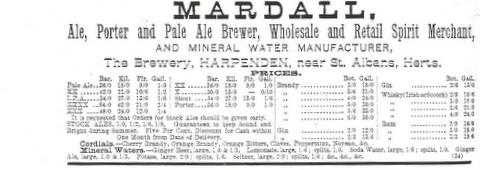 Mardall 1890 price list. Credit: LHS archives After Mardall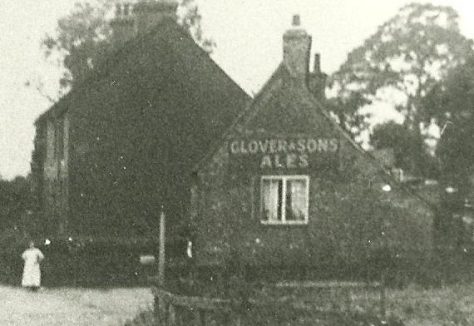 The Red Cow, Coldharbour – a Glover pub. Credit: LHS archives Four years later in 1897 the whole concern was sold to Richard Glover of London. At that time the brewery had 37 tied public houses, 8 of them in Harpenden. Its beer sales exceeded 5,000 barrels per year, and “a considerable spirit trade was carried on” Glover completely modernised the premises. He demolished all the brewery buildings, and built a new brewery at the southern end of the site, incorporating the large tower block, which was a prominent feature of the High Street for many years.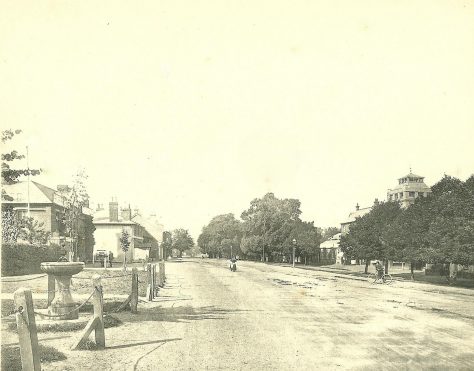 Harpenden High Street showing brewery tower on the right. Credit: H Valentine, LHS archives Mrs Mardall continued to live in Brewery House until her death in 1912. (It remained a private residence, with an extensive garden behind it, until 1951, when it was sold for shops.) In 1902 the brewery combined with Pryor Reid, of Hatfield, thus becoming the biggest brewery in the county, although the two businesses continued to run separately under their own names. Glover and Sons Ltd. went into liquidation in 1919 and sold their brewery and public houses to J W Green, Luton brewers. Green kept the public houses, but closed the brewery down.
The buildings were taken over by Waverley Mills, manufacturing sportswear. The Hatfield part of Pryor Reid closed in 1920. The managing director’s son, Lieut. Geoffrey Reid, had been killed in the Great War while in charge of a machine gun section. As there was then no-one to take over the business, it was sold to Benskins. | In the early 1920s the single story building at the side of Brewery House, which had been used as offices and wine cellars, was sold to the North Metropolitan Electric Company, who brought electricity to Harpenden in 1923. It became their office. A sub station which contained the transformers was built on the land behind. With nationalisation the North Metropolitan became Eastern Electricity, and they altered the front of the building to create a showroom. Eastern Electricity closed on 30th March 1996: the building was then used intermittently by charities, until Good Value Pine took it over. And now it has become Harpenden’s newest public conveniences, part of the impressive new supermarket extension. The Waverley Mills moved in 1936 to the recently vacated Victoria cinema building in Amenbury Lane. The old Brewery building was then demolished, and three shops, for Woolworths, Sainsburys, and Boots were built on the site. Woolworths has since become Argos*. Boots extended into Sainsburys, when they, Sainsburys, moved along the High Street to their present site. Eric Brandreth October 2003 Addendum 2013*Harpenden public library moved from Vaughan Road into the Argos site April/May 2013. When the site in Vaughan Road was cleared for the new police station, these photos of the brewery cellars were taken. The cellars were possibly the source of the ‘tunnels under Harpenden’ stories. 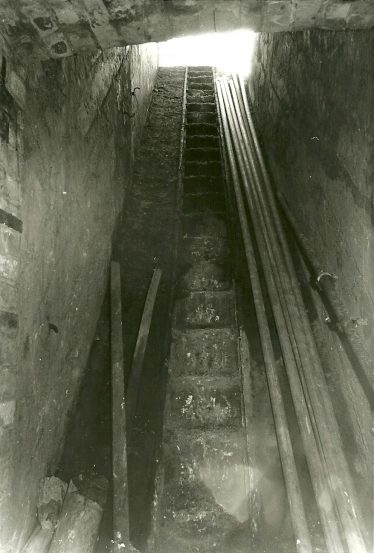 Stairs and ramp for getting barrels into cellars. Credit: LHS archives – 5640  End of one of cellars showing ventilation hole. Sleepers against wall were backing for targets when used as shooting range during the war. Credit: LHS archives – 5654 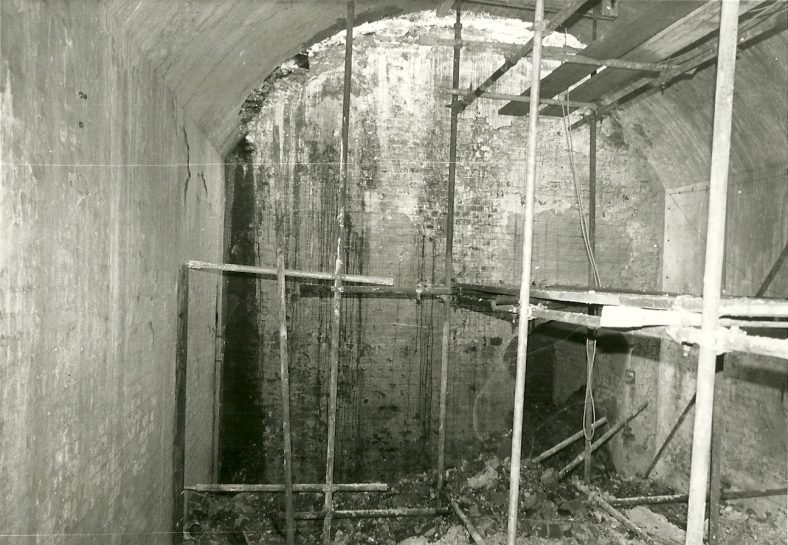 Bricked up access to other cellars. Credit: LHS archives – 5649  Wall plaque in brewery vault. Credit: LHS archives – 5650 |
|
|
|
|
|
| | |



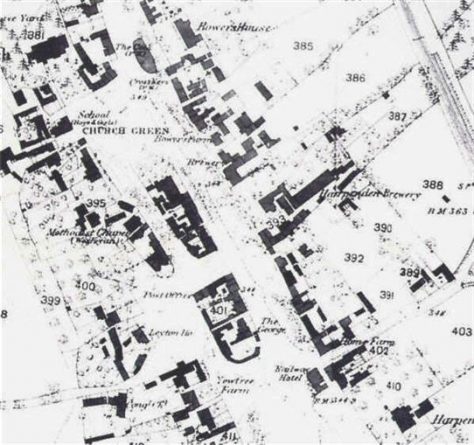









No Comments
Add a comment about this page